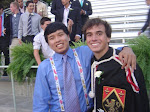After we finished with a few cups of tea, we headed outside to tour the village’s cathedral. The whole region of villages consists of somewhere around 300 people, little more than my graduating high school class, but the villagers in one village still built a massive cathedral in the middle of the 18th century. It is shaped like a ship and goes from West to East, just like the Volga River it was built parallel to, and has a summer cathedral with a large tower, a winter cathedral, and a bell tower. It is so impressive that these villagers sank so much time, effort and money into building such a beautiful building, especially when one considers how very modest their own homes are in comparison.
The cathedral is surrounded by a graveyard on all four sides with paths cut in between. There’s a grave for a 7 year-old at one spot, and a little ways away, Jaime noticed that another grave claims that its owner lived to be 121, from1857-1978.
We first entered the summer cathedral, which had some frescoes still faintly visible on its walls. They began renovating this cathedral in 2000. We then entered the former winter cathedral, which made the summer cathedral look fully functioning by comparison. The winter cathedral had dirt in place of a floor, wood and other construction materials in piles strewn everywhere, and little to suggest this was once a house of worship.
The current winter cathedral was next door. It was very small, and we stayed in there for only a moment before heading up the many rickety wooden ladders to the top of the bell tower. From the top of the tower we had a panoramic view of the flat Russian plains. For some reason Willa Cather’s O Pioneers jumped into my head as I was taking panoramic shots of the prairie.
On our way down the wooden ladders, I thought about the faith and devotion that went into the bricks and clay and egg-based mortar of this building. And I thought more and decided that this cathedral in some ways has just as much religious significance as the Sistine Chapel or the Western Wall in Jerusalem.
We spent some time in the backyard of the house where we ate lunch picking different kinds of round blue berries, eating them and spitting out the big seeds. And after a few of us took turns in the outhouse, we headed to the lake named ram’s horn in Russian that divided one village from another. We played a little with the well that many villagers still use for fresh water, and then we crossed the wooden planked bridge to go to the other town.
While walking along the main road in the other town, a man shouted at us. Nadia answered him in Russian and we kept walking, thinking the exchange over. But the old, unshaven and red-faced man followed us out of his garden and kept talking. Nadia translated that he remembered Nadia from one of her previous volunteer groups, and trusted her, so we were invited into his house. We went in, all the volunteers exchanging excited and confused glances, and the man showed us his massive stove that heated the entire house. Nadia explained that it was so big that you could sleep on it when it got really cold in the winter.
The man, who we later found out was named Alexander, posed in front of the stove for pictures. Then to no one’s surprise explained that he was drunk and had been celebrating a friend’s birthday for the last three days. In short order Alexander mentioned that his wife was in the hospital, that Americans and Russians should be friends, that his father died in the war and nobody knows where he is buried. Through the course of our stay in his house he added that people are easier to recognize in beards, and repeatedly challenged Nadia on her translations despite knowing no English.
He then offered to play us a song on his accordion. While he went to look for it, coming in and out of the kitchen repeatedly, we played with one of his cats, who Meg nicknamed Circles, because he kept walking around in circles. Another cat came in as two dogs barked outside, and Alexander finally returned with the accordion. He sat down and played us a few songs, sometimes singing boisterously. Eventually, Nadia told him it was time for his last song and we made our escape.
Subscribe to:
Post Comments (Atom)


No comments:
Post a Comment